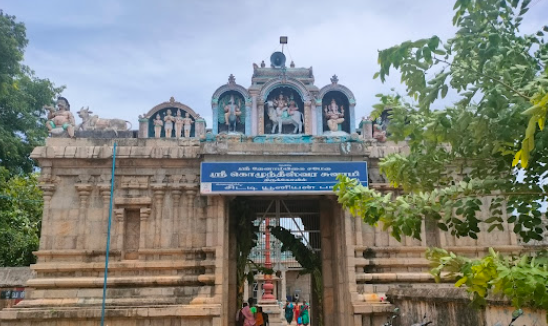- Sthalapuranam 1 :
In ancient times, the demon Vruddhasura was terrorising the Devas. In their plight, Indira, the king of the Devas, sought the help of Lord Brahma for protection. Brahma revealed that to defeat the demon, Indira would need to obtain the backbone of Sage Thatheesi. This backbone could be transformed into a Vajrayudha weapon, which was the only means to kill Vruddhasura. Brahma explained that the backbone’s strength stemmed from a unique event: before the Devas joined in churning the Milk Ocean, they had entrusted their weapons to Sage Thatheesi. The sage had safely stored all these weapons in his mouth while he continued his penance. Over time, the weapons melted and merged with his backbone, granting it incredible strength.
When Indira approached Sage Thatheesi and expressed his need, the sage willingly parted with his backbone. With this powerful weapon, Indira defeated the demon; however, he incurred the Brahma Hatya dosha, a grave sin associated with the act of killing a Brahmin.
To atone for this sin, Indira sought the counsel of his Guru. The Guru advised him to go to Earth and perform worship of Lord Shiva. He instructed Indira to find a Shivalinga located beneath a Vanni tree, formed from drops of nectar. Additionally, the Guru suggested that Indira create a spring and use its water for performing Abishek (ritual bathing) of the Lord.
Indira diligently followed his Guru's advice. Upon worshipping Lord Shiva at that location, he was absolved of his sin. In gratitude, the place came to be known as Indirapuram. It was also called Kottur, derived from the fact that Indira’s white elephant, Iravadham, had drawn a line (referred to as kodu in Tamil) at the site.
- Sthalapuranam 2 :
Ramba, a renowned dancer in the celestial realm, was cursed to descend to Earth due to some wrongs she had committed. Determined to regain her original status, she engaged in severe penance at the temple dedicated to the Lord.
During her penance, Ramba adopted a rigorous posture: she pressed her left leg down, bent her right leg, placed her left hand on her right leg, and rested her right hand on her head, all while being surrounded by flames. This intense devotion was aimed at seeking forgiveness and the grace of the Lord to return to her celestial home.
Her fervent worship drew the attention of various celestial beings, including Brahma, Indra, Airavatam (Indra's divine elephant), and Indrasena, who came to witness her dedication and devotion.
